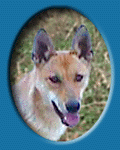Banbury Cross Farm
Carolina Dogs / American Dingos

"You're one of the very few who have actually preserved the breed and cared about them remaining true. We need more of that, and need to support those who do it right." -Raluca
The American Rare Breed Association's
Carolina Dog Breed Standard




General Appearance
-
The Carolina Dog is a medium built dog, manifesting the features of most pariah/feral dog types. The large, erect ears (designed for optimal sound retrieval and possibly body temperature regulation), long, curved tail (used for signaling and communication) and short, dense coat have been naturally selected for to ensure survival under free-ranging conditions. Carolina Dogs should be kept in a natural state, with no trimming (other than nails) allowed at any time.
Temperament
-
The Carolina Dog is naturally suspicious of strangers. Around those it knows, it is quiet, reserved, somewhat aloof, yet affectionate. Unprovoked aggression toward any human is not to be tolerated.
Head and Neck
-
Skull: The skull is broad between the ears, moderately rounded with a distinct furrow extending down between the eyes. There is a slight but distinct stop. the head forms a wide triangle-shaped wedge, tapering to a long, distinctly pointed muzzle. Muzzle length is equal to or slightly greater than skull length.
-
Teeth: A full set of strong, rather large teeth should meet in a level or scissors bite.
-
Eyes: Eyes are almond-shaped, dark brown in color and set obliquely. Eye rims are black.
-
Nose: The nose is large and black. Lighter colored noses often occur in white and cream dogs, but black noses are to be preferred.
-
Ears: Ears are large and slightly rounded at the tip. They are held erect when alert and folded back along the head and neck at other times. They are well set on top of the head, pointed slightly forward. Drop ears are a major fault.
-
Neck: Graceful and versatile, strong and well placed on the shoulders.
Forequarters
-
The chest is narrow to medium in width. Shoulders are well laid back. Forelegs are straight with moderate bone and well muscled. Pasterns are strong and of good length. Feet are moderately small, yet strong with a compliment of thick padded toes and strong nails.
Body
-
The back is moderately long and straight, rising slightly over the loin. The chest cavity is deep, rising to a distinct waist in an obvious tuck-up.
Hindquarters
-
Strong and muscular, they are set under the body. They are well angulated for tremendous reach and drive, allowing for greater agility. Thighs are well muscled, lean and powerful in appearance. Tail: A continuation of the spine, its carriage varies depending on mood. There is moderate brush with lighter shadings on the underside. When alert, the fishhook or sickle tail is carried at a 45 degree angle from the horizontal. At other times, the tail is held low or tucked between the legs.
Coat
-
The coat is short with definite seasonal differences. The winter coat is heavier than the summer coat due to the abundance of undercoat. The hair is short and smooth on the head, ears and legs. Longer, coarser guard hairs extend down the topline. When aroused, these hairs are carried erect to create a more imposing outline. The coat is never long, wavy or curly.
Color
-
1.) Ginger--ranging from light cream to deep red, with paler markings over the shoulders and along the muzzle. Dark masks often occur, particularly in juveniles. White feet, face blaze and tail tip are common.
-
2.) Black and Tan--dull (reddish) to brilliant black with tan markings as follows: small spots over each eye, on sides of muzzle and cheeks, forechest, ends of legs and undersurface of tail. The tan areas lie between the black coat color and white markings. White markings occur as follows: on sides of muzzle and cheeks, underside of jaw, neck, chest, and stomach. White may or may not appear on legs and feet.
-
3.) Piebald--overall white or cream body color with random large spots of red, tan or black. Only one spot color should occur on an individual dog, and colored spots should not constitute more than 50 percent of total body color. White/cream should be predominate.
Saddleback pattern, Irish markings, and brindling are a disqualification.
Height and Weight
-
Average height is 17 to 24 inches, but can vary according to build. Average weight is 40 to 60 pounds. Type and symmetry are more important than actual size.
Gait and Movement
-
Low, smooth, effortless and free-moving.

